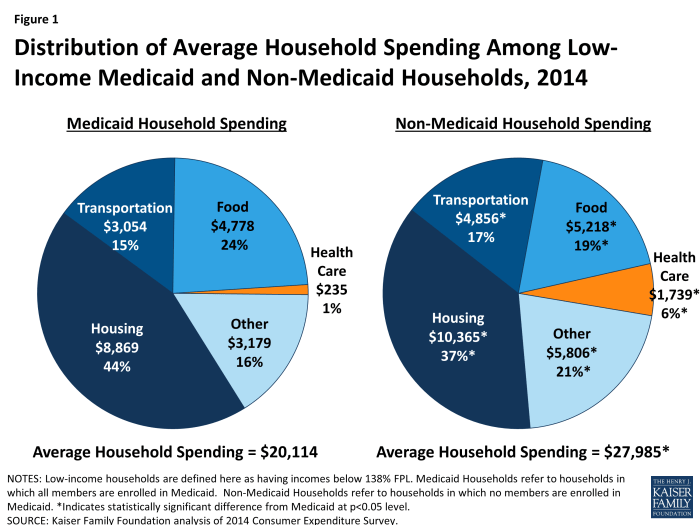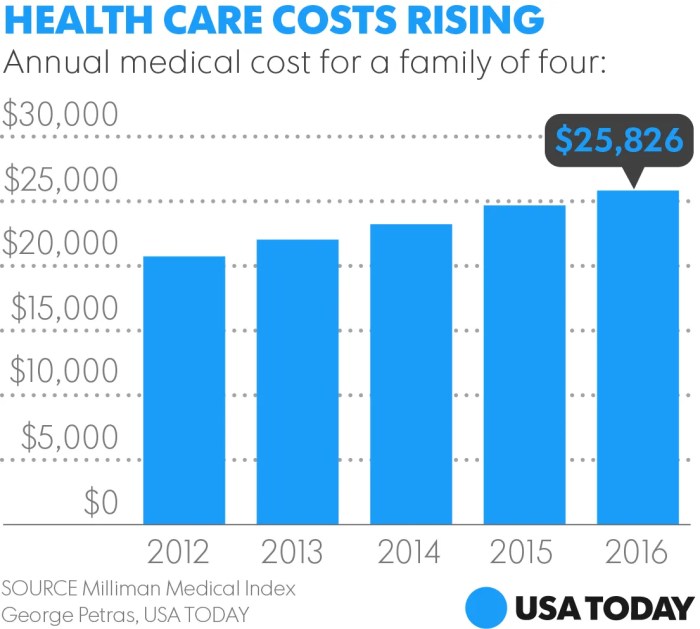
Exploring the realm of Healthcare Costs for Families, this introduction delves into the challenges faced by families in accessing affordable healthcare, the impact of different healthcare systems on costs, and the crucial role of preventive care in reducing overall expenses.
As we navigate through the complexities of healthcare expenses and access, we uncover key insights into managing costs effectively and ensuring families receive the care they need without financial strain.
Healthcare Access

Accessing affordable healthcare can be a significant challenge for many families, especially those with limited financial resources. The high cost of medical services, prescription medications, and health insurance premiums can create barriers to obtaining the care they need. This often leads to families delaying or forgoing necessary medical treatment, which can ultimately result in more serious health issues and higher costs in the long run.Geographic location plays a crucial role in determining access to healthcare services for families.
Rural areas, in particular, may have fewer healthcare providers and facilities, making it difficult for families to access timely and quality care. Limited transportation options and long travel distances can further impede their ability to seek medical attention when needed. This disparity in access can exacerbate health inequalities and lead to poorer health outcomes for families living in underserved areas.Preventive care is essential in reducing overall healthcare costs for families.
By focusing on preventive measures such as regular check-ups, vaccinations, and screenings, families can detect and address health issues early on, preventing them from developing into more serious and costly conditions. Investing in preventive care can help families avoid expensive emergency room visits, hospitalizations, and treatments for advanced illnesses, ultimately saving them money in the long term while promoting better health and well-being.
Healthcare Costs
Healthcare costs can vary significantly depending on the healthcare system in place, with some countries offering universal healthcare coverage while others rely more on private insurance. These differences can have a direct impact on the financial burden faced by families when seeking medical treatment.
Comparison of Healthcare Costs in Different Systems
In countries with universal healthcare systems, such as Canada or the UK, families typically do not have to pay out-of-pocket for essential medical services. On the other hand, in countries with predominantly private insurance systems like the United States, families may face high deductibles, copayments, and premiums.
Common Medical Procedures with High Costs
- Emergency room visits
- Surgical procedures
- Cancer treatments
- Maternity care
- Prescription medications
Impact of Out-of-Pocket Expenses
Out-of-pocket expenses can place a significant strain on families’ finances, especially when facing unexpected medical emergencies or chronic conditions requiring ongoing treatments. High healthcare costs can lead to financial instability, debt, and even bankruptcy for some families, affecting their overall well-being and quality of life.
Healthcare Providers
Primary care physicians play a crucial role in managing healthcare costs for families by providing preventive care, managing chronic conditions, and coordinating overall healthcare services. They focus on early detection and treatment, which can help avoid costly emergency room visits or hospitalizations.
Role of Primary Care Physicians
- Primary care physicians are the first point of contact for families seeking medical care.
- They provide routine check-ups, screenings, and vaccinations to prevent illnesses and detect health issues early.
- By managing chronic conditions such as diabetes or hypertension, they help prevent complications that could lead to expensive treatments.
- Primary care physicians also coordinate care with specialists, ensuring that families receive appropriate and cost-effective treatment.
Specialist Care and Increased Costs
Specialist care can contribute to increased healthcare costs for families due to the higher fees associated with their expertise and services. While necessary for specific health conditions, frequent visits to specialists can add up quickly and strain a family’s budget.
Importance of Long-Term Relationships
Building long-term relationships with healthcare providers, including primary care physicians and specialists, is essential for managing costs effectively. These relationships allow for better coordination of care, continuity in treatment plans, and personalized attention based on the family’s medical history and needs.
Health Insurance
Health insurance plays a crucial role in helping families mitigate the high costs associated with healthcare services. By providing coverage for medical expenses, health insurance ensures that families have access to necessary treatments without facing financial burdens.
Public vs. Private Health Insurance Options
- Public health insurance options, such as Medicaid and Medicare, are typically funded by the government and designed to provide coverage for low-income individuals and senior citizens.
- Private health insurance, on the other hand, is offered by commercial insurance companies and employers, providing a range of coverage options for families based on premiums and benefits.
Co-payments and Deductibles
Co-payments and deductibles are important components of health insurance plans that can impact the overall costs for families:
- Co-payments: These are fixed amounts that insured individuals must pay for certain services or medications, typically at the time of service. Co-payments help share the cost of healthcare between the individual and the insurance provider.
- Deductibles: Deductibles refer to the amount of money that insured individuals must pay out of pocket before their insurance coverage kicks in. Higher deductibles often result in lower monthly premiums but require families to cover more upfront costs.
Health Policies
Government healthcare policies play a significant role in determining the healthcare costs that families face. These policies can directly impact the affordability of healthcare services, access to insurance coverage, and the overall quality of care that families receive.
Influence of Government Healthcare Policies
Government healthcare policies can have a profound impact on healthcare costs for families. For example, policies that promote competition among healthcare providers can help drive down costs by giving families more options to choose from. On the other hand, policies that restrict access to certain services or medications may lead to increased costs for families who require those treatments.
- Government policies such as the Affordable Care Act (ACA) have aimed to increase access to affordable health insurance for families, thereby reducing their out-of-pocket costs for healthcare services.
- Changes in Medicaid and Medicare policies can also have a direct impact on the healthcare costs that families face, especially for low-income households and elderly individuals.
- Government regulations on drug pricing, insurance coverage, and healthcare delivery models can all influence the overall cost of healthcare for families.
Recent Policy Changes
Recent policy changes have had a significant impact on the affordability of healthcare for families. For example, the repeal of certain provisions of the ACA has led to increased uncertainty around insurance coverage and rising premiums for many families.
- The expansion of short-term health plans and association health plans under recent policy changes has provided some families with more affordable insurance options, but these plans may offer limited coverage compared to traditional insurance policies.
- Changes to Medicaid eligibility requirements and funding levels have also affected the ability of low-income families to access necessary healthcare services without facing high costs.
Health Policy Advocacy
Health policy advocacy plays a crucial role in addressing rising healthcare costs for families. Advocacy efforts can help bring attention to the needs of families struggling to afford healthcare services and push for policy changes that improve access and affordability.
- Advocacy organizations work to educate policymakers and the public about the impact of healthcare costs on families, advocating for solutions that prioritize affordability and quality of care.
- By engaging in advocacy efforts, families and healthcare providers can work together to promote policies that support preventative care, chronic disease management, and other measures that can help reduce long-term healthcare costs.
Health Records
Electronic health records play a crucial role in managing healthcare costs for families by providing a centralized platform for storing and accessing critical medical information. These digital records help streamline communication among healthcare providers and reduce unnecessary tests and procedures, ultimately leading to cost savings for families.
Importance of Electronic Health Records
- Electronic health records allow for easy access to a patient’s medical history, medications, allergies, and test results, enabling healthcare providers to make more informed decisions.
- By having a comprehensive view of a patient’s health information, healthcare professionals can avoid repetitive tests and procedures, reducing unnecessary costs for families.
- Electronic health records facilitate better coordination of care among different healthcare providers, ensuring that all members of the care team are on the same page regarding treatment plans and progress.
Privacy Concerns
- One of the main concerns related to sharing health records among healthcare providers is the potential risk of unauthorized access to sensitive patient information.
- Healthcare organizations must implement strict security measures to safeguard electronic health records and ensure that only authorized personnel have access to patient data.
- Patients should be informed about how their health information is being shared and have the option to control who can view their electronic health records.
Improving Coordination of Care
- Electronic health records allow for seamless sharing of information among healthcare providers, promoting better coordination of care for families with multiple healthcare needs.
- With electronic health records, healthcare providers can easily track a patient’s progress, medication adherence, and treatment plans, leading to more effective and personalized care.
- By reducing duplicate services and unnecessary procedures, electronic health records help families save both time and money while improving the overall quality of care they receive.
Health Screening

Regular health screenings play a crucial role in preventing costly health conditions for families. By detecting potential health issues early on, screenings can help reduce overall healthcare costs and promote wellness.
Examples of Preventive Screenings
- Annual physical exams: These check-ups can help monitor overall health and detect any underlying conditions.
- Blood pressure screenings: Regular monitoring can help identify hypertension early and prevent related complications.
- Cholesterol tests: Screening for cholesterol levels can help reduce the risk of heart disease and stroke.
- Mammograms and Pap smears: These screenings are essential for early detection of breast and cervical cancer in women.
- Colonoscopies: Recommended for adults over a certain age, colonoscopies can help detect colorectal cancer early.
Role of Health Screenings
Health screenings are instrumental in promoting wellness by allowing healthcare providers to address health concerns proactively. By identifying risk factors and potential issues before they escalate, screenings can help reduce the need for costly medical interventions such as surgeries or long-term treatments. Regular screenings empower individuals to take control of their health and make informed decisions to maintain their well-being.
In conclusion, understanding the dynamics of healthcare costs for families is essential in navigating the complex healthcare landscape. By prioritizing preventive care, leveraging health insurance options, and establishing strong relationships with healthcare providers, families can better manage their expenses and enhance their overall well-being.
Detailed FAQs
How can families access affordable healthcare?
Families can access affordable healthcare by exploring government assistance programs, community health centers, and negotiating payment plans with healthcare providers.
What are some common medical procedures that lead to high healthcare costs for families?
Procedures like surgeries, emergency room visits, and long-term treatments for chronic conditions can significantly contribute to high healthcare costs for families.
How do health screenings help in reducing healthcare costs for families?
Regular health screenings can detect health issues early, allowing for timely interventions that prevent costly treatments later on, ultimately reducing overall healthcare costs for families.






